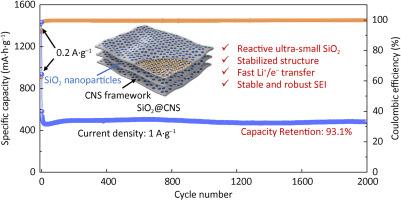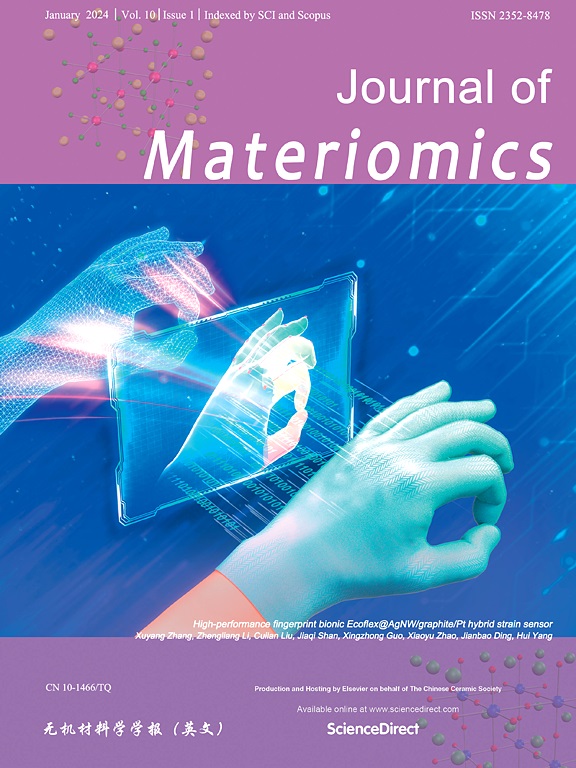Effective binding sufficiently-small SiO2 nanoparticles within carbon nanosheets framework enables a high-performing and durable anode for lithium-ion batteries
IF 9.6
1区 材料科学
Q1 CHEMISTRY, PHYSICAL
引用次数: 0
Abstract
Silica (SiO2), with its high theoretical capacity and abundance, holds great potential as anode material for lithium-ion batteries (LIBs). However, its practical application is hindered by inherently low conductivity and significant volume change during cycling. In this work, we present a simple yet effective strategy to address these challenges by homogeneously binding high-density, ultra-small SiO2 nanoparticles within a carbon nanosheet framework (denoted as SiO2@CNS). In this design, densely packed sufficiently-small SiO2 nanoparticles (about 6 nm) ensure high electrochemical reactivity, while the conductive and flexible CNS matrix facilitates rapid ion/electron transfer and buffers volume changes during cycling. As a result, the SiO2@CNS anode delivers a remarkable capacity of 607.3 mA⸱h/g after 200 cycles at 0.1 A/g, superior rate capability (407.4 mA⸱h/g at 2 A/g) and outstanding durability, retaining 93.1% of its capacity after 2000 cycles at 1 A/g. In-situ transmission electron microscopy and ex-situ microscopic and spectroscopic analyses reveal moderate volume variation and exceptional structural stability during cycling, supported by the formation of a robust solid-electrolyte interphase that underpins its long-lasting performance. Full cells paired with commercial LiFePO4 cathode exhibit outstanding rate and cycling performance. This work provides valuable insights into developing highly-efficient SiO2-based anodes for high-performance LIBs.


在碳纳米片框架内有效结合足够小的SiO2纳米颗粒可以为锂离子电池提供高性能和耐用的阳极
二氧化硅(SiO2)具有较高的理论容量和丰度,作为锂离子电池(LIBs)的负极材料具有很大的潜力。然而,它的实际应用受到固有的低电导率和循环过程中显着的体积变化的阻碍。在这项工作中,我们提出了一种简单而有效的策略,通过在碳纳米片框架内均匀结合高密度,超小SiO2纳米颗粒(表示为SiO2@CNS)来解决这些挑战。在该设计中,密集排列的足够小的SiO2纳米颗粒(约6 nm)确保了高电化学反应性,而导电和柔性的CNS基质促进了离子/电子的快速转移,并缓冲了循环过程中的体积变化。结果,SiO2@CNS阳极在0.1 a /g下循环200次后提供了607.3 mA⸱h/g的显着容量,优越的倍率能力(407.4 mA⸱h/g, 2 a /g)和出色的耐久性,在1 a /g下循环2000次后保持了93.1%的容量。原位透射电子显微镜和非原位显微镜和光谱分析显示,在循环过程中,适度的体积变化和特殊的结构稳定性,由坚固的固体电解质界面的形成支持,支撑其持久的性能。与商用LiFePO4阴极配对的全电池具有出色的倍率和循环性能。这项工作为开发用于高性能lib的高效sio2基阳极提供了有价值的见解。
本文章由计算机程序翻译,如有差异,请以英文原文为准。
求助全文
约1分钟内获得全文
求助全文
来源期刊

Journal of Materiomics
Materials Science-Metals and Alloys
CiteScore
14.30
自引率
6.40%
发文量
331
审稿时长
37 days
期刊介绍:
The Journal of Materiomics is a peer-reviewed open-access journal that aims to serve as a forum for the continuous dissemination of research within the field of materials science. It particularly emphasizes systematic studies on the relationships between composition, processing, structure, property, and performance of advanced materials. The journal is supported by the Chinese Ceramic Society and is indexed in SCIE and Scopus. It is commonly referred to as J Materiomics.
 求助内容:
求助内容: 应助结果提醒方式:
应助结果提醒方式:


